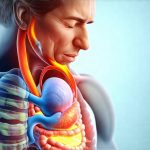Chronic upper digestive issues are remarkably common, often dismissed as simple heartburn or indigestion. Millions suffer from persistent bloating, nausea, belching, and discomfort after meals, leading many on a frustrating journey of dietary changes and over-the-counter remedies. While these symptoms can indicate gastrointestinal problems like acid reflux or irritable bowel syndrome, they can also be surprisingly deceptive, masking underlying issues originating not in the stomach or intestines but in the gallbladder – an often overlooked organ with a significant impact on digestion. The persistent nature of these seemingly minor complaints frequently leads to misdiagnosis and ineffective treatment plans, leaving individuals feeling helpless and seeking answers.
The gallbladder, though small, plays a vital role in fat digestion. It stores bile, a fluid produced by the liver, which is released into the small intestine when we consume fats. This process breaks down fats for absorption, enabling our bodies to utilize essential nutrients. When the gallbladder isn’t functioning optimally – due to gallstones, inflammation (cholecystitis), or dyskinesia (impaired emptying) – it can disrupt this process, leading to a cascade of digestive symptoms that mimic other more common conditions. These disruptions often don’t cause dramatic, acute pain immediately; instead, they manifest as chronic, low-grade discomfort that is easily attributed to less serious causes, making the connection to gallbladder dysfunction difficult to identify without proper investigation. Understanding chronic inflammation in the gut and its impact can be crucial for overall health.
Understanding Gallbladder Dysfunction and Its Digestive Impact
Gallbladder issues rarely present as a single, obvious symptom. Instead, they tend to be subtle and insidious, often mimicking other gastrointestinal disorders. This makes accurate diagnosis challenging, requiring careful consideration of a patient’s complete medical history and a thorough evaluation of their symptoms. The hallmark of many gallbladder-related digestive problems is fat malabsorption. When bile isn’t adequately released or functioning correctly, the body struggles to digest fats effectively. Undigested fat in the gut can lead to bloating, gas, diarrhea, and even steatorrhea (pale, greasy stools). But the effects don’t stop there; this disruption also impacts nutrient absorption, potentially leading to deficiencies over time.
Beyond fat malabsorption, gallbladder dysfunction can trigger a range of other digestive complaints. Many individuals experience nausea, particularly after consuming fatty foods. This isn’t necessarily due to food poisoning or stomach upset but rather the gallbladder struggling to process the fats and sending signals of distress. Belching and heartburn are also common symptoms, as undigested fat ferments in the gut, producing gas and potentially causing acid reflux. The chronic inflammation associated with gallstones or cholecystitis can irritate the digestive tract, contributing to ongoing discomfort and sensitivity. It’s important to note that these symptoms aren’t always consistent; they can fluctuate in intensity and may be triggered by specific foods or situations. Recognizing food allergies that present as digestive issues is important for proper diagnosis.
The location of pain, when present, is also often misleading. While acute gallbladder attacks usually cause sharp right upper quadrant abdominal pain, chronic dysfunction tends to manifest as a more diffuse discomfort higher up in the stomach area, closely resembling indigestion. This can easily lead doctors to focus on gastric issues rather than investigating the gallbladder. The insidious nature of these symptoms means people often live with them for years, accepting them as ‘just part of life’ or attributing them to stress and poor diet. Many find themselves struggling with symptoms that might also be related to anxiety and panic attacks.
Types of Gallbladder Issues Leading to Chronic Indigestion
Several conditions can compromise gallbladder function and lead to chronic upper digestive issues. Gallstones, the most common culprit, are hardened deposits that form inside the gallbladder. They can block bile ducts, causing inflammation and pain, or they can remain asymptomatic for years until they create problems. However, even small gallstones can disrupt bile flow, leading to impaired digestion without causing acute pain.
Another condition is cholecystitis, which refers to inflammation of the gallbladder, usually caused by gallstones blocking a duct. While often associated with severe abdominal pain, chronic cholecystitis can present as persistent indigestion and bloating. Finally, gallbladder dyskinesia occurs when the gallbladder doesn’t empty properly, even without stones or inflammation. This can be due to nerve or muscle dysfunction, and it leads to similar digestive symptoms as other gallbladder issues but is often harder to diagnose because standard imaging tests may not reveal any structural abnormalities. Often, a HIDA scan (hepatobiliary iminodiacetic acid scan) is needed to assess gallbladder emptying function. Understanding silent reflux and how it mimics other conditions can help with diagnosis.
Diagnosing Underlying Gallbladder Issues
Diagnosing the root cause of chronic indigestion requires a systematic approach and a willingness to look beyond common explanations. A thorough medical history, focusing on dietary habits, symptom triggers, and bowel movements, is crucial. Physical examination should include palpation of the abdomen to assess for tenderness or distension. Initial tests often involve blood work to evaluate liver function and rule out other conditions. However, standard digestive tests like endoscopies are unlikely to reveal gallbladder problems, highlighting the need for specific imaging studies:
- Ultrasound: This is usually the first line of investigation. It can detect gallstones but isn’t always accurate in identifying dyskinesia or chronic inflammation.
- HIDA Scan (Hepatobiliary Iminodiacetic Acid Scan): This nuclear medicine test assesses gallbladder emptying function and is particularly useful for diagnosing dyskinesia. A radioactive tracer is injected intravenously, and a scan tracks how well the gallbladder empties bile in response to stimulation.
- MRCP (Magnetic Resonance Cholangiopancreatography): This imaging technique provides detailed images of the bile ducts and can help identify blockages or structural abnormalities that might not be visible on ultrasound.
The Role of Dietary Changes and Lifestyle Modifications
Once gallbladder dysfunction is suspected or diagnosed, dietary changes and lifestyle modifications can significantly alleviate symptoms. A low-fat diet is often recommended to reduce the burden on the gallbladder and minimize digestive distress. Focusing on easily digestible foods and avoiding fried, greasy, and processed items can make a substantial difference. Small, frequent meals are also preferable to large meals, as they place less stress on the digestive system.
- Increase fiber intake: Fiber aids digestion and helps regulate bowel movements.
- Stay hydrated: Adequate hydration is essential for optimal bile flow.
- Manage stress: Stress can exacerbate digestive symptoms; incorporating stress-reducing techniques like yoga or meditation may be beneficial. Learning how chewing thoroughly can also help with digestion.
Exploring Treatment Options Beyond Diet
While dietary modifications often provide relief, more advanced treatment options may be necessary in some cases. Ursodeoxycholic acid (UDCA) is a medication that can dissolve small gallstones and improve bile flow. However, it’s not effective for all types of stones or dyskinesia. In severe cases of chronic cholecystitis or dyskinesia, gallbladder removal (cholecystectomy) might be considered. This is typically performed laparoscopically, a minimally invasive procedure with a relatively quick recovery time. While living without a gallbladder isn’t ideal, many individuals adapt well and experience significant improvement in their digestive symptoms after surgery. It’s vital to discuss the risks and benefits of each treatment option with your healthcare provider to determine the most appropriate course of action for your individual circumstances. Remember that self-diagnosing or self-treating can be harmful; professional medical evaluation is crucial for accurate diagnosis and effective management of chronic upper digestive issues.


















